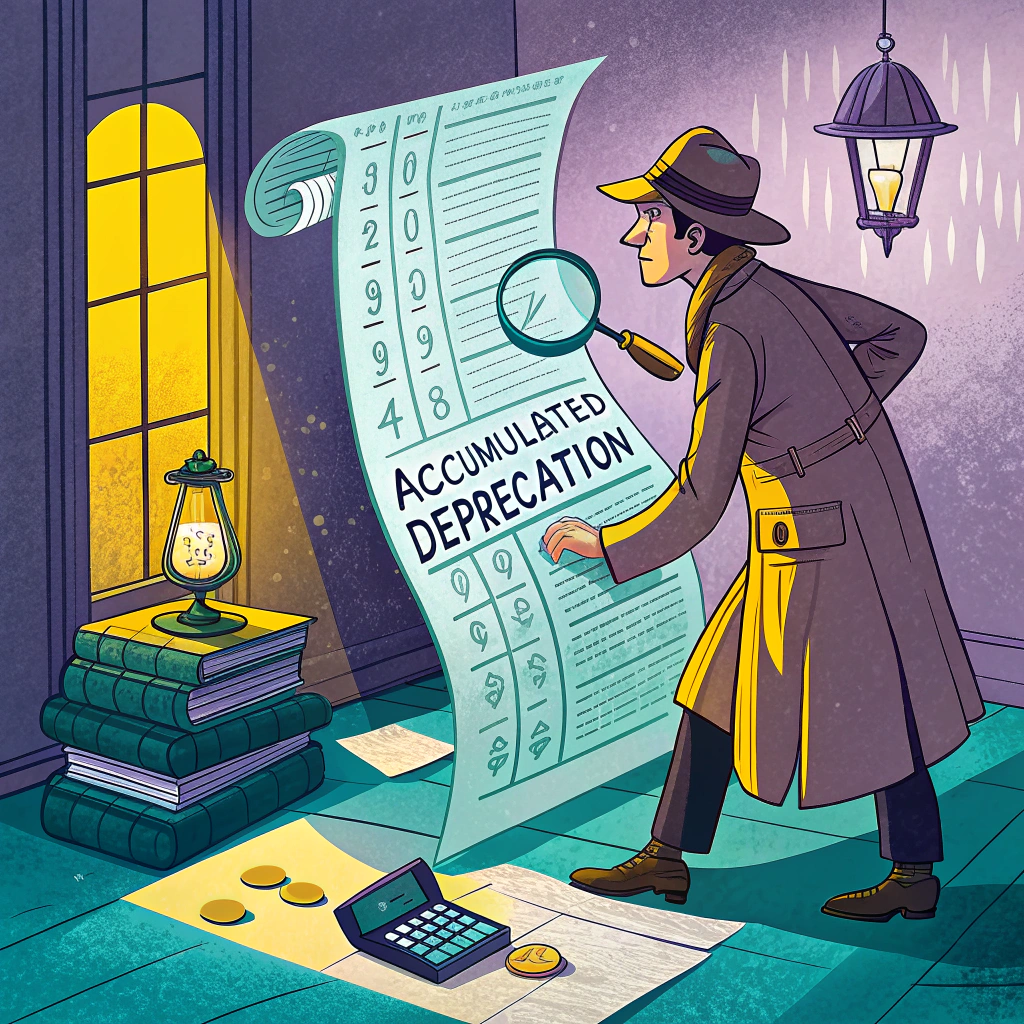Ever stared at a balance sheet and wondered, “Where the heck is accumulated depreciation hiding?” You’re not alone! Accumulated depreciation is that sneaky number lurking in the long-term contra asset section, specifically under Property, Plant, and Equipment (PP&E). Think of it as the tally of all the wear and tear your company’s assets have experienced over time.
Before we dive into the nitty-gritty, let’s set the stage. Balance sheets are like your company’s financial selfie—capturing assets, liabilities, and equity at a specific moment. They show not just what you own, but also how much it’s worth now versus when you first got it. And accumulated depreciation? That’s the total amount your assets have depreciated since you started using them. It’s like keeping tabs on how much your company’s shiny new toys have lost their luster.
In this rollercoaster ride through accounting, we’ll unravel the mysteries of balance sheets and accumulated depreciation. By the end, you’ll know exactly where accumulated depreciation is lurking—and why it matters. So buckle up; it’s time to make accounting a little less boring and a whole lot more understandable!
Related: Common Stock in the Balance Sheet
Understanding the Balance Sheet
First things first: what’s a balance sheet, and why should you care? Think of it as a financial snapshot your company takes at the end of the day—capturing a moment in its financial life. It’s the ultimate “here’s where we stand” report that shows what you own, what you owe, and what’s left over. Pretty handy, right?
The balance sheet isn’t just for show; it’s a crucial tool for investors, owners, accountants, and even that nosy neighbor who’s always asking about your business. It helps track your company’s financial health and keeps everyone in the loop about earnings and spending. No wonder it’s also known as the statement of financial condition—fancy, huh?
Alongside its pals—the income statement and the cash flow statement—the balance sheet is one of the big three in financial reporting. But let’s zero in on the balance sheet’s trio of main components:
- Assets: The goodies your company owns—everything from cash in the bank to that fancy espresso machine everyone loves.
- Liabilities: The debts and obligations—like the bills you keep meaning to pay or the loans you’ve taken out.
- Equity: What’s left over for you or the shareholders after all the debts are paid. Think of it as your company’s net worth or the “rainy day fund” (or maybe “sunny day fund” if we’re being optimistic).
These three amigos form the fundamental accounting equation:
Assets = Liabilities + Equity
Yes, it’s like financial karma—the books must balance. If they don’t, you’ve got some explaining to do! It’s the golden rule of accounting, and breaking it is a big no-no.
See also: Is Accounts Receivable an Asset?
What Is Accumulated Depreciation on the Balance Sheet?
Alright, let’s tackle the big question: what exactly is accumulated depreciation, and why is it hogging space on your balance sheet? Think of accumulated depreciation as the sum total of all the wear and tear your assets have experienced since day one. It’s like keeping a tally of how much value your company car has lost since you drove it off the lot—or how much that trusty old laptop has depreciated since you first unboxed it.

Accumulated depreciation is recorded on the credit side of your journal entries to offset the asset’s value. This means it’s a contra asset account—it reduces the gross amount of the related asset on the balance sheet. Fancy terminology aside, it’s simply acknowledging that your assets aren’t as fresh as they used to be.
Companies rely heavily on capital assets like land, equipment, buildings, vehicles—you know, all the big-ticket items that keep the business running. But here’s the catch: these assets don’t stay shiny and new forever. They lose value over time due to wear and tear, technological updates, or maybe just because someone spilled coffee on the keyboard one too many times.
According to accounting rules (because we all love rules, right?), companies must depreciate these assets over their useful lives. That means spreading out the cost of the asset over the years it’s expected to be in service. The depreciation expense for each period appears on the income statement, while the accumulated depreciation—to date—shows up on the balance sheet.
Here’s a quick breakdown:
- Depreciation Expense: The amount an asset depreciates in a single period. This shows up on the income statement.
- Accumulated Depreciation: The total depreciation of the asset since it was first used. This is the contra asset account on the balance sheet.
So, accumulated depreciation increases over time as depreciation expenses continue to pile up. It’s like watching the mileage rack up on your car’s odometer—inevitable but important to track.
But here’s the kicker: accumulated depreciation can’t exceed the cost of the asset. Once an asset is fully depreciated, its book value on the balance sheet will be zero (unless it has some salvage value). When the asset is eventually sold or retired (farewell, old friend!), the accumulated depreciation is reversed, wiping it off the balance sheet.
Remember, accumulated depreciation applies to long-term capital assets—not your stash of sticky notes or office snacks. So you won’t be calculating depreciation on supplies that are quickly used up and replaced.
What Type of Account Is Accumulated Depreciation on the Balance Sheet?
So, where does accumulated depreciation hang out at the balance sheet party? It’s a contra asset account. In plain English, that means it’s listed under assets but has a credit balance—yeah, it’s a bit of a rebel. While most assets have debit balances (because they’re valuable things you own), accumulated depreciation has a credit balance because it reduces the value of those assets.
Think of it as the yin to the asset’s yang. The accumulated depreciation account pairs up with the related asset account to show the asset’s net book value. So, on the balance sheet, you’ll see the original cost of the asset, then accumulated depreciation right below it, and finally the net book value (which is the original cost minus accumulated depreciation).

Contra asset accounts like accumulated depreciation help give a more accurate picture of your company’s assets by accounting for wear and tear, obsolescence, and the passage of time. It’s like acknowledging that your high school jeans don’t fit quite the same anymore—and that’s okay.
As long-term assets continue to depreciate, the accumulated depreciation account grows, increasing the credit balance and further reducing the net book value of the asset. This keeps the balance sheet balanced (because we can’t have chaos in accounting!) and reflects the true economic value of your assets.
Related: Is Dividends an Asset?
Where Is Accumulated Depreciation on the Balance Sheet?
So, you’ve been flipping through the balance sheet like it’s the latest bestseller, but where exactly is accumulated depreciation hiding? Time to put on your accounting detective hat!
Accumulated depreciation is typically listed right below the related fixed asset on the balance sheet. You’ll find it nestled under the Property, Plant, and Equipment (PP&E) section, acting all nonchalant. Remember, it’s a contra asset account with a credit balance, so it reduces the total value of your assets.
Since accumulated depreciation only applies to fixed assets—not your stash of petty cash or those office supplies—you’ll see it in the fixed assets section. Companies often have a dedicated PP&E section to separate these long-term assets from current assets. It’s like having a VIP area for the big-ticket items.
Accumulated depreciation is reducing the gross value of the assets to show their net book value.
Some companies prefer to group long-term assets and show one lump sum for accumulated depreciation. Others go line by line, detailing the original cost, accumulated depreciation, and net book value for each asset. It’s like choosing between a detailed itemized receipt or a summarized bill at a restaurant—either way, you get the total, but one gives you more specifics.
Whether a company chooses to list assets individually or group them, the key is to provide an accurate representation of financial health.
Takeaways
Alright, we’ve covered a lot of ground (and hopefully had a little fun along the way). Let’s wrap things up with some key takeaways:

- Accumulated Depreciation: It’s the total amount of depreciation for an asset since it was first put to use. Think of it as the sum of all the wear and tear.
- Contra Asset Account: Accumulated depreciation is a contra asset account, meaning it reduces the value of the related asset on the balance sheet.
- Balance Sheet Placement: You’ll find accumulated depreciation under the Property, Plant, and Equipment (PP&E) section, right below the related asset. It’s doing its part to keep the balance sheet balanced.
- Depreciation Expense vs. Accumulated Depreciation: Depreciation expense shows up on the income statement for a single period, while accumulated depreciation is the total depreciation to date and appears on the balance sheet.
- Importance of Tracking: Recording accumulated depreciation provides a more accurate picture of an asset’s current value, helping businesses make informed financial decisions.
Understanding where accumulated depreciation fits on the balance sheet isn’t just an accounting exercise—it’s essential for grasping the true value of your company’s assets and making smarter financial moves. So the next time you’re combing through financial statements, you’ll know exactly where to find this elusive figure. Happy accounting!
